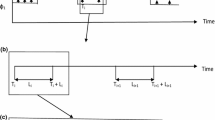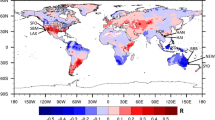Abstract
This chapter discusses various approaches for stochastic rainfall synthesis focusing on methods for generation of short time step precipitation as required for flood studies. A brief introduction motivates the utilisation of rainfall generators for flood modelling. Then special characteristics of rainfall as stochastic process are discussed. The rainfall models presented in the following are classified in alternating renewal models, time series models, point process models, disaggregation and resampling approaches. They are usually applied for continuous unconditional simulation of rainfall series in time and/or in space. Two case studies at the end of the chapter illustrate the application of daily and hourly space-time precipitation models for flood studies.
Access this chapter
Tax calculation will be finalised at checkout
Purchases are for personal use only
Similar content being viewed by others
References
Acreman MC (1990) Simple stochastic model of hourly rainfall for Farnborough, England. Hydrol Sci J 35(2):119–148
Akaike H (1974) A new look at the statistical model identification. IEEE Trans Automatic Control AC-19:716–723
Aronica GT, Candela A (2007) Derivation of flood frequency curves in poorly gauged Mediterranean catchments using a simple stochastic hydrological rainfall-runoff model. J Hydrol 347(1–2):132–142
Bárdossy A (1998) Generating precipitation time series using simulated annealing. Water Resour Res 34(7):1737–1744
Bárdossy A, Plate EJ (1992) Space-time model for daily rainfall using atmospheric circulation patterns. Water Resour Res 28(5):1247–1259
Beven K, Freer J (2001) Equifinality, data assimilation, and uncertainty estimation in mechanistic modelling of complex environmental systems using the GLUE methodology. J Hydrol 249(1–4):11–29
Blazkova S, Beven K (2004) Flood frequency estimation by continuous simulation of subcatchment rainfalls and discharges with the aim of improving dam safety assessment in a large basin in the Czech Republic. J Hydrol 292(1–4):153–172
Brandsma T, Buishand TA (1998) Simulation of extreme precipitation in the Rhine basin by nearest neighbour resampling. Hydrol Earth Syst Sci 2:195–209
Bras RL, Rodriguez-Iturbe I (1994) Random functions and hydrology. Dover, New York, NY, 559 pp
Buishand TA, Brandsma T (2001) Multisite simulation of daily precipitation and temperature in the Rhine basin by nearest-neighbor resampling. Water Resour Res 37(11):2761–2776
Cameron DS, Beven KJ, Tawn J, Blazkova S, Naden P (1999) Flood frequency estimation by continuous simulation for a gauged upland catchment (with uncertainty). J Hydrol 219(3–4):169–187
Chang TJ, Kavvas ML, Delleur JW (1984a) Daily precipitation modelling by discrete autoregressive moving average processes. Water Resour Res 20:565–580
Chang TJ, Kavvas ML, Delleur JW (1984b) Modelling of sequences of wet and dry days by binary discrete autoregressive moving average processes. J Climate Appl Meteorol 23:1367–1378
Coles S (2001) An introduction to statistical modeling of extreme values. Springer, London, 208 pp
Cowpertwait PSP (2006) A spatial-temporal point process model of rainfall for the Thames catchment, UK. J Hydrol 330(3–4):586–595
Delleur JW, Kavvas ML (1978) Stochastic models for monthly rainfall forecasting and synthetic generation. J Appl Meteorol 17:1528–1536
De Michele C, Salvadori G (2003) A Generalized Pareto intensity-duration model of storm rainfall exploiting 2-Copulas. J Geophys Res 108 (D2):4067. doi:10.1029/2002JD002534
Efron B, Tibshirani RJ (1998) An introduction to the bootstrap. Chapman and Hall, New York, NY, 436 pp
Foufoula-Georgiou E, Georgakakos KP (1991) Hydrologic advances in space-time precipitation modeling and forcasting. In: Bowles DS, Connel O (eds) Recent advances in the modeling of hydrologic systems. Kluwer, Dordrecht, 47–65 pp
Frigessi A, Haug O, Rue H (2003) A dynamic mixture model for unsupervised tail estimation without threshold selection. Extremes 5:219–235
Gaume E, Mouhous N, Andrieu H (2007) Rainfall stochastic disaggregation models: calibration and validation of a multiplicative cascade model. Adv Water Resour 30(5):1301–1319
Gilks W, Richardson S, Spiegelhalter D (1996) Markov chain Monte Carlo methods in practice. CRC Press, Boca Raton, FL, 486 pp
Grace RA, Eagleson PS (1966) The synthesis of short-time-increment rainfall sequences. Hydrodynamics Laboratory, Massachusetts Institute of Technology, Cambridge, MA
Güntner A, Olsson J, Calver A, Gannon B (2001) Cascade-based disaggregation of continuous rainfall time series: the influence of climate. Hydrol Earth Syst Sci 5:145–164
Haan CT, Allen DM, Street JO (1976) A Markov Chain model of daily rainfall. Water Resour Res 12(3):443–449
Haberlandt U (1998) Stochastic rainfall synthesis using regionalized model parameters. J Hydrol Eng 3(3):160–168
Haberlandt U, Ebner von Eschenbach A-D, Buchwald I (2008) A space-time hybrid hourly rainfall model for derived flood frequency analysis. Hydrol Earth Syst Sci 12:1353–1367
Hastings W (1970) Monte Carlo sampling methods using Markov Chains and their applications. Biometrika 57:97–109
Hipel KW, McLeod AI (1994) Time series modelling of water resources and environmental systems. Elsevier, Amsterdam, 1013 pp.
Hosking JRM, Wallis JR (1997) Regional frequency analysis: an approach based on L-moments. Cambridge University Press, New York, NY, 240 pp.
Hundecha Y, Pahlow M, Schumann A (2009) Modeling of daily precipitation at multiple locations using a mixture of distributions to characterize the extremes. Water Resour Res 45:W12412. doi:10.1029/2008WR007453
Hutchinson MF (1995) Stochastic space-time weather models from ground-based data. Agric Forest Meteorol 73:237–264
Jacobs PA, Lewis PAW (1978a) A discrete time series generated by mixture I: correlation and run properties. J R Stat Soc B 40(1):94–105
Jacobs PA, Lewis PAW (1978b) A discrete time series generated by mixture II: asymptotic properties. J R Stat Soc B 40(2):222–228
Katz RW (1977) Precipitation as a chain-dependent process. J Appl Meteorol 16:671–676
Kavvas ML, Delleur JW (1975) Removal of periodicities by differencing and month subtraction. J Hydrol 26:335–353
Koutsoyiannis D, Onof C, Wheater HS (2003) Multivariate rainfall disaggregation at a fine timescale. Water Resour Res 39(7): 1173. doi:10.1029/2002WR001600
Lall U, Sharma A (1996) A nearest neighbor bootstrap for resampling hydrological time series. Water Resour Res 32:679–693
Lovejoy S, Schertzer D (2006) Multifractals, cloud radiances and rain. J Hydrol 322(1–4):59–88
Lu M, Yamamoto T (2008) Application of a random cascade model to estimation of design flood from rainfall data. J Hydrol Eng 13(5):385–391
Mielke PW, Jr (1973) Another family of distributions for describing and analyzing precipitation data. J Appl Meteorol 10(2):275–280
Moretti G, Montanari A (2008) Inferring the flood frequency distribution for an ungauged basin using a spatially distributed rainfall-runoff model. Hydrol Earth Syst Sci 12:1141–1152
Nelsen RB (2006) An introduction to Copulas. Springer, New York, NY, 270 pp
Olsson J (1998) Evaluation of a scaling cascade model for temporal rainfall disaggregation. Hydrol Earth Syst Sci 2:19–30
Onof C, Chandler RE, Kakou A, Northrop P, Wheater HS, Isham V (2000) Rainfall modelling using Poisson-cluster processes: a review of developments. Stoch Environ Res Risk Assess 14:384–411
Pegram GGS, Clothier AN (2001) High resolution space–time modelling of rainfall: the "string of beads" model. J Hydrol 241(1–2):26–41
Rajagopalan B, Lall U (1999) A k-nearest-neighbor simulator for daily precipitation and other weather variables. Water Resour Res 35:3089–3101
Richardson CW (1982) Stochastic simulation of daily precipitation, temperature, and solar radiation. Water Resour Res 17:182–190
Rodríguez-Iturbe I, Cox DR, Isham V (1987a) Some models for rainfall based on stochastic point processes. Proc R Soc, London A 410:269–288
Rodríguez-Iturbe I, Febres de Power B, Valdés JB (1987b) Rectangular pulses point process models for rainfall: analysis of empirical data. J Geophys Res 92(D8):9645–9656
Roldan J, Woolhiser DA (1982) Stochastic daily precipitation models 1. A comparison of occurrence processes. Water Resour Res 18(5):1451–1459
Scharffenberg WA, Fleming MJ (2005) Hydrologic modelling system, HEC-HMS. User's Manual, 248 pp
Stedinger JR, Vogel RM, Foufoula-Georgiou E (1993) Frequency analysis of extreme events. In: Maidment DR (ed) Handbook of hydrology. MacGraw-Hill, New York, NY, pp 18.1–18.66
Stehlík J, Bárdossy A (2002) Multivariate stochastic downscaling model for generating daily precipitation series based on atmospheric circulation. J Hydrol 256(1–2):120–141
Stern RD, Coe R (1984) A model fitting analysis of daily rainfall data (with discussion). J R Stat Soc A 147:1–34
Vrac M, Naveau P (2007) Stochastic downscaling of precipitation: from dry events to heavy rainfalls. Water Resour Res 43:W07402. doi:10.1029/2006WR005308
Wendling U, Schellin H-G, Thomä M (1991) Bereitstellung von täglichen Informationen zum Wasserhaushalt des Bodens für die Zwecke der agrarmeteorologischen Beratung. Meteorologische Zeitschrift 41:468–474
Wheater H, Chandler R, Onof C, Isham V, Bellone E, Yang C, Lekkas D, Lourmas G, Segond ML (2005) Spatial-temporal rainfall modelling for flood risk estimation. Stoch Environ Res Risk Assess (SERRA) 19(6):403–416
Wilks DS (1998) Multisite generalization of a daily stochastic precipitation generation model. J Hydrol 210(1–4):178–191
Woolhiser DA, Roldan J (1982) Stochastic daily precipitation models. 2. A comparison of distribution amounts. Water Resour Res 18:1461–1468
Author information
Authors and Affiliations
Corresponding author
Editor information
Editors and Affiliations
Rights and permissions
Copyright information
© 2011 Springer Science+Business Media B.V.
About this chapter
Cite this chapter
Haberlandt, U., Hundecha, Y., Pahlow, M., Schumann, A.H. (2011). Rainfall Generators for Application in Flood Studies. In: Schumann, A. (eds) Flood Risk Assessment and Management. Springer, Dordrecht. https://doi.org/10.1007/978-90-481-9917-4_7
Download citation
DOI: https://doi.org/10.1007/978-90-481-9917-4_7
Published:
Publisher Name: Springer, Dordrecht
Print ISBN: 978-90-481-9916-7
Online ISBN: 978-90-481-9917-4
eBook Packages: Earth and Environmental ScienceEarth and Environmental Science (R0)




